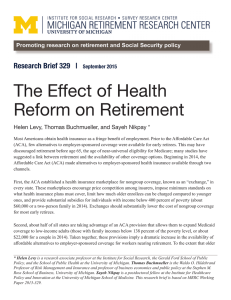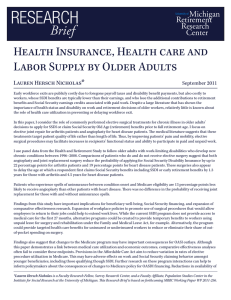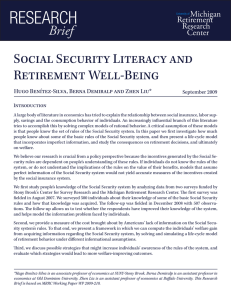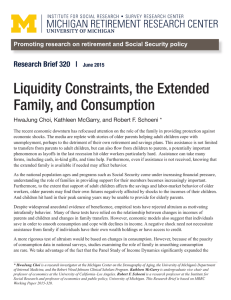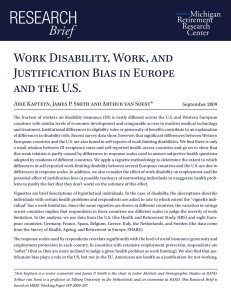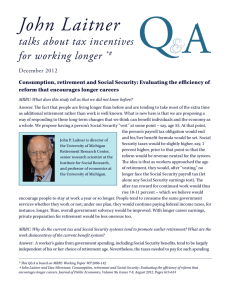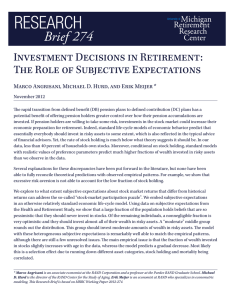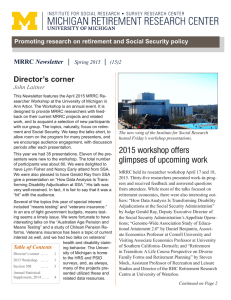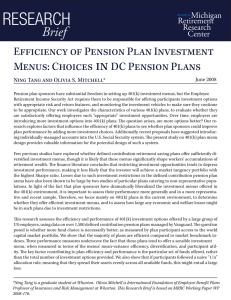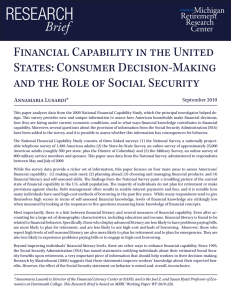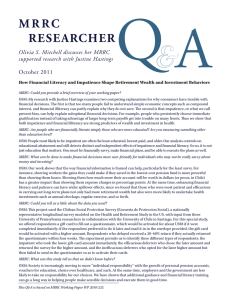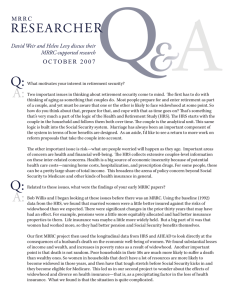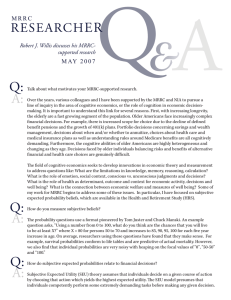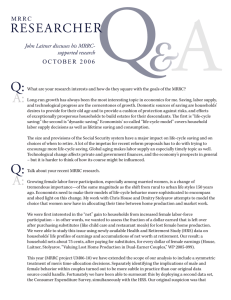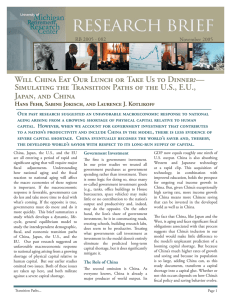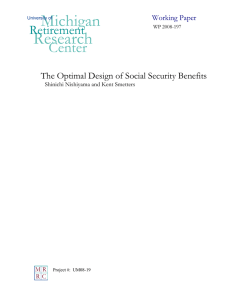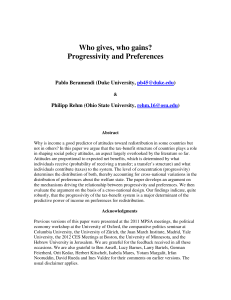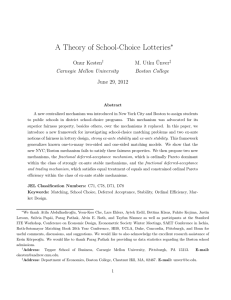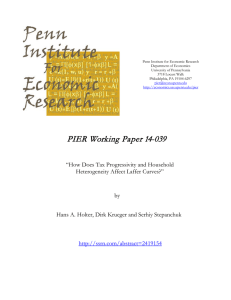RESEARCH The Optimal Design of Social Security Benefits Brief
advertisement
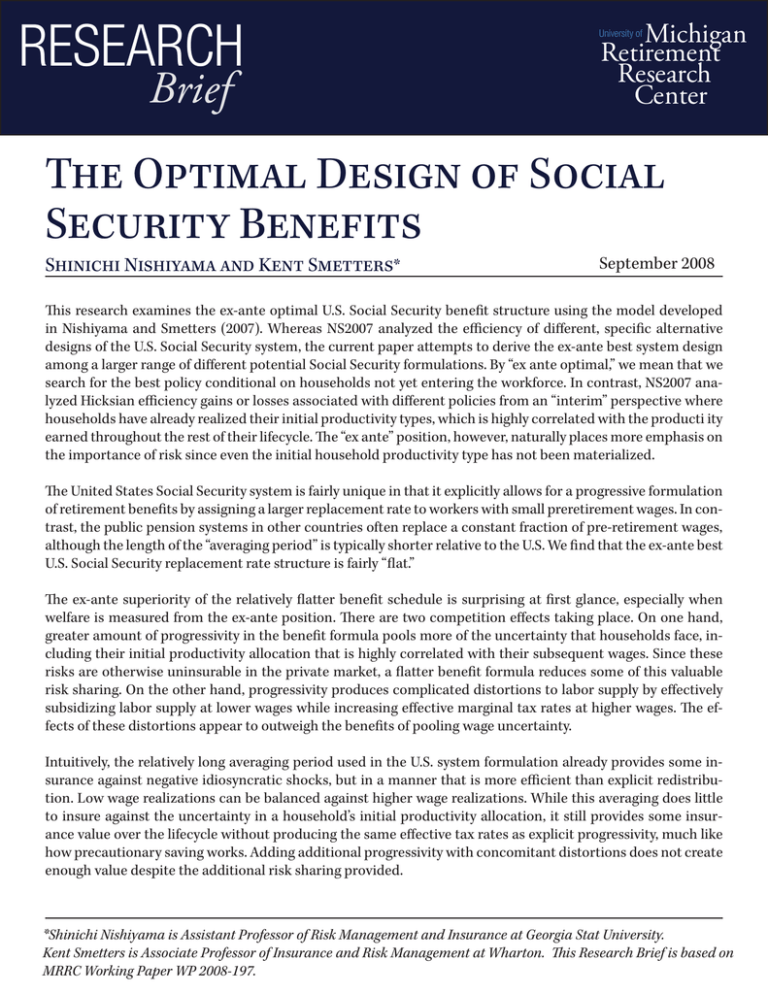
RESEARCH Brief Michigan Retirement Research Center University of The Optimal Design of Social Security Benefits Shinichi Nishiyama and Kent Smetters* September 2008 This research examines the ex-ante optimal U.S. Social Security benefit structure using the model developed in Nishiyama and Smetters (2007). Whereas NS2007 analyzed the efficiency of different, specific alternative designs of the U.S. Social Security system, the current paper attempts to derive the ex-ante best system design among a larger range of different potential Social Security formulations. By “ex ante optimal,” we mean that we search for the best policy conditional on households not yet entering the workforce. In contrast, NS2007 analyzed Hicksian efficiency gains or losses associated with different policies from an “interim” perspective where households have already realized their initial productivity types, which is highly correlated with the producti ity earned throughout the rest of their lifecycle. The “ex ante” position, however, naturally places more emphasis on the importance of risk since even the initial household productivity type has not been materialized. The United States Social Security system is fairly unique in that it explicitly allows for a progressive formulation of retirement benefits by assigning a larger replacement rate to workers with small preretirement wages. In contrast, the public pension systems in other countries often replace a constant fraction of pre-retirement wages, although the length of the “averaging period” is typically shorter relative to the U.S. We find that the ex-ante best U.S. Social Security replacement rate structure is fairly “flat.” The ex-ante superiority of the relatively flatter benefit schedule is surprising at first glance, especially when welfare is measured from the ex-ante position. There are two competition effects taking place. On one hand, greater amount of progressivity in the benefit formula pools more of the uncertainty that households face, including their initial productivity allocation that is highly correlated with their subsequent wages. Since these risks are otherwise uninsurable in the private market, a flatter benefit formula reduces some of this valuable risk sharing. On the other hand, progressivity produces complicated distortions to labor supply by effectively subsidizing labor supply at lower wages while increasing effective marginal tax rates at higher wages. The effects of these distortions appear to outweigh the benefits of pooling wage uncertainty. Intuitively, the relatively long averaging period used in the U.S. system formulation already provides some insurance against negative idiosyncratic shocks, but in a manner that is more efficient than explicit redistribution. Low wage realizations can be balanced against higher wage realizations. While this averaging does little to insure against the uncertainty in a household’s initial productivity allocation, it still provides some insurance value over the lifecycle without producing the same effective tax rates as explicit progressivity, much like how precautionary saving works. Adding additional progressivity with concomitant distortions does not create enough value despite the additional risk sharing provided. *Shinichi Nishiyama is Assistant Professor of Risk Management and Insurance at Georgia Stat University. Kent Smetters is Associate Professor of Insurance and Risk Management at Wharton. This Research Brief is based on MRRC Working Paper WP 2008-197. Our results have very practical policy implications. While partial privatization of the U.S. Social Security system is likely “off the table” for the foreseeable future, significant projected shortfalls still remain in the Social Security program. Tough choices, therefore, will have to be made regarding increasing revenue and/or decreasing benefits. We have not explicitly modeled the expected shortfalls in this paper; indeed, such imbalances are generally not consistent with standard rational expectations models where budget constraints are assumed to hold. But, our analysis does suggest that some caution is in order for reforms that focus heavily on making the benefit structure even more progressive, such as “progressive price indexing,” which has been a quite popular option debated during the past couple years. Other features of the U.S. -- namely, the large computation period -- naturally provide risk sharing but in a less distorting manner. University of Michigan Retirement Research Center Institute for Social Research 426 Thompson Street Room 3026 Ann Arbor, MI 48104-2321 Phone: (734) 615-0422 Fax: (734) 615-2180 mrrc@isr.umich.edu www.mrrc.isr.umich.edu The research reported herein was performed pursuant to a grant from the U.S. Social Security administration (SSA) through the Michigan Retirement Research Center (MRRC). The findings and conclusions expressed are solely those of the author(s) and do not represent the views of SSA, any agency of the federal government, or the MRRC. Regents of the University of Michigan Julia Darrow, Laurence B. Deitch, Olivia P. Maynard, Rebecca McGowan, Andrea Fischer Newman, Andrew C. Richner, S. Martin Taylor, Katherine E. White, and Mary Sue Coleman, ex officio
